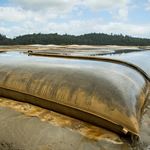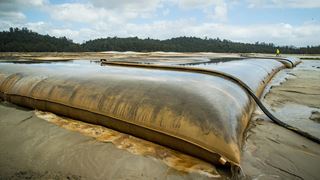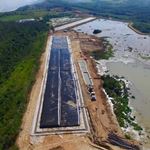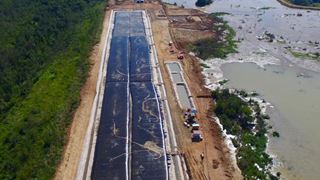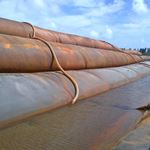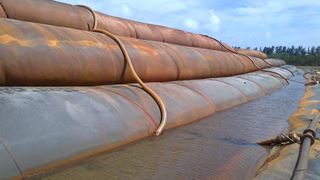Case story
Geotube® Dewatering and Containment of Rare Earth Processing Residue
Malaysia,
Processing and refining rare earth minerals results in a waste stream that is required to be managed and stored in an environmentally secure way. Slurry from the refining process is usually dewatered using conventional mechanical dewatering equipment and the dry waste is then disposed in a secure landfill. This case study describes the use of Geotube® dewatering technology to dewater rare earth waste slurry with the use of geotextile tubes at this Asian rare earth production plant as an alternative to mechanical methods.
The challenge
The problems faced by this processing plant relates to the effectiveness of long-term storage which was further complicated by the lack of free land space to accommodate a growing waste stream and ensuring correct handling and storage.
The design
As an alternative to mechanical dewatering and conventional waste storage, Geotube® dewatering units was proposed to dewater and store process residue and integrate Geotube® systems into the overall plant process.
A Rapid Dewatering Test (RDT) or Jar Test evaluation of the sludge was carried out to determine the polymer type and dosing rate needed to flocculate the sludge (see Figure1a and 1b). The concept involved the supply of polymer in powder form which requires a preparation and injection set-up to deliver polymer into the incoming slurry stream using a mixing manifold. Figure 2a and 2b shows the polymer set-up and polymer dosing pumps for polymer preparation and injection into the delivery slurry stream ahead into the tubes.
The nature of the project required a Geotube® configuration that facilitated sequential pumping and filling of multiple tubes. Figure 3 shows the incoming slurry delivery pipeline with multiple valves to control and direct the slurry flow. To monitor the dosing efficiency, a sampling point was installed immediately after the manifold mixing unit and a program of regular sampling was developed.
More than 100 units of Geotube® dewatering tubes with a circumference of 36.6m with varying lengths of between 39m and 57m stacked five levels high were installed over a year as part of an integrated plant waste capture program. In total, 180,000m³ of dry solids were captured within the tubes.
The construction
Figures 4a to 4d shows the activities associated with the installation of Geotube® dewatering units. To secure wastewater runoff, a dewatering pad lined with HDPE membrane was constructed. Prior to deployment of the Geotube® units, the tube positions was marked on the geomembrane liner. Each Geotube® dewatering unit weighing about 1.3 tonnes required lifting and positioning by a mobile crane. The Geotube® dewatering tubes was then unrolled and unfolded manually by the operators or by a mechanical winch attached on a four wheel-drive vehicle. A 100mm diameter flexible hose was used to connect the main slurry pipe to the Geotube® dewatering tubes. The three filling ports of each Geotube® dewatering tubes was then connected to the flexible hoses and the slurry inflow for each port was regulated by a gate valve installed between the main slurry pipe and the flexible hose.
The performance
Geotube® dewatering technology has the advantage of handling huge residue volumes while achieving a significantly high solids capture rate at a low capital investment. The increased dewatering capability enabled the plant to accommodate the sudden rise in demand for rare earth minerals. This allowed the plant to schedule a complete maintenance overhaul of their mechanical dewatering equipment without affecting production and resolved the constraint of lack of disposal area at site. Geotube® dewatering saved the client substantial costs in capital expenditure as well as maintenance and operation costs.
Geotube® Containment and Dewatering of rare earth process residue
Figure 1a : RDT evaluation; shows the sludge sample, effluent and dewatered solids of the RDT
Figure 1b : RDT evaluation; shows the flocculate slurry
Figure 2a: Polymer make-down unit (PMU)
Figure 2b: Polymer dosing pumps
Figure 3: Incoming slurry delivery pipeline with multiple valves control connected into Geotube® units using flexible hoses
Figure 4a: Unloading of Geotube® dewatering tubes from open top container
Fibure 4b: Layout of Geotube® dewatering tubes over the marked positions on the geomembrane liner
Figure 4c: Commissioning of Geotube® dewatering works
Figure 4d: Fifth layer stacking of Geotube® dewatering tubes
Figure 4e: Dewatered cake contained within the Geotube® dewatering tubes at the end-of-dewatering cycles



